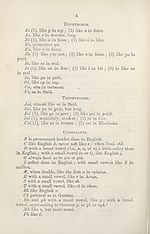Books and other items printed in Gaelic from 1871 to 1900 > Elementary lessons in Gaelic
(9) [Page 3] - Gaelic lessons
Download files
Complete book:
Individual page:
Thumbnail gallery: Grid view | List view
![(9) [Page 3] - Gaelic lessons](https://deriv.nls.uk/dcn17/1062/5119/106251192.17.jpg)
GAELIC LESSONS.
I—INTRODUCTORY.
The apparent uncouthness of written and printed Gaelic
is altogether on the surface, and is, to some extent, due to
its being spelled etymologically. In writing Gaelic the first
care is that the derivation of each word be manifest. In
one dialect—the Manx—however, this plan is not followed,
and the orthography is purely phonetic—that is, words are
spelled according to pronunciation—hence that dialect is
more simple to write, and presents a smoother appearance.
In our Scottish Gaelic the rule of etymological orthography
is strictly adhered to ; whilst English adheres to neither
system.
Another cause of the seeming urigainliness of our written
language is that it is now denuded of its proper dress, and
clothed in the less flexible habiliments of the Roman alphabet.
In Ireland the Celtic characters are still used; but Scotch
Gaelic is written wiLh eighteen letters of the common R,oman
al[)habet. The rejected letters are—j, k, q, v, w, x, y, and z.
Those which are retained are pronounced more after the
Continental than the English fashion.
The following is a table of Gaelic letter-sounds :—■
Vowels.
A (1), like u in bwt; (2) as in bat; (3) d,, as in calm;
(4) before II or nn, ail.
E (1), as in met; (2) like a in fame.
/ (1), as in hit; (2) like ea in eat; (3) i, like ea in
zeal.
0 (1), as in bolt; (2) o, as in bold.
U (1), as in iuv; (2) as in twne ; (3) u, as in rwle.
I—INTRODUCTORY.
The apparent uncouthness of written and printed Gaelic
is altogether on the surface, and is, to some extent, due to
its being spelled etymologically. In writing Gaelic the first
care is that the derivation of each word be manifest. In
one dialect—the Manx—however, this plan is not followed,
and the orthography is purely phonetic—that is, words are
spelled according to pronunciation—hence that dialect is
more simple to write, and presents a smoother appearance.
In our Scottish Gaelic the rule of etymological orthography
is strictly adhered to ; whilst English adheres to neither
system.
Another cause of the seeming urigainliness of our written
language is that it is now denuded of its proper dress, and
clothed in the less flexible habiliments of the Roman alphabet.
In Ireland the Celtic characters are still used; but Scotch
Gaelic is written wiLh eighteen letters of the common R,oman
al[)habet. The rejected letters are—j, k, q, v, w, x, y, and z.
Those which are retained are pronounced more after the
Continental than the English fashion.
The following is a table of Gaelic letter-sounds :—■
Vowels.
A (1), like u in bwt; (2) as in bat; (3) d,, as in calm;
(4) before II or nn, ail.
E (1), as in met; (2) like a in fame.
/ (1), as in hit; (2) like ea in eat; (3) i, like ea in
zeal.
0 (1), as in bolt; (2) o, as in bold.
U (1), as in iuv; (2) as in twne ; (3) u, as in rwle.
Set display mode to:
![]() Universal Viewer |
Universal Viewer | ![]() Mirador |
Large image | Transcription
Mirador |
Large image | Transcription
Images and transcriptions on this page, including medium image downloads, may be used under the Creative Commons Attribution 4.0 International Licence unless otherwise stated. ![]()
| Rare items in Gaelic > Books and other items printed in Gaelic from 1871 to 1900 > Elementary lessons in Gaelic > (9) [Page 3] - Gaelic lessons |
|---|
| Permanent URL | https://digital.nls.uk/106251190 |
|---|
| Description | Out-of-copyright books printed in Gaelic between 1631 and 1900. Also some pamphlets and chapbooks. Includes poetry and songs, religious books such as catechisms and hymns, and different editions of the Bible and the Psalms. Also includes the second book ever published in Gaelic in 1631. |
|---|

